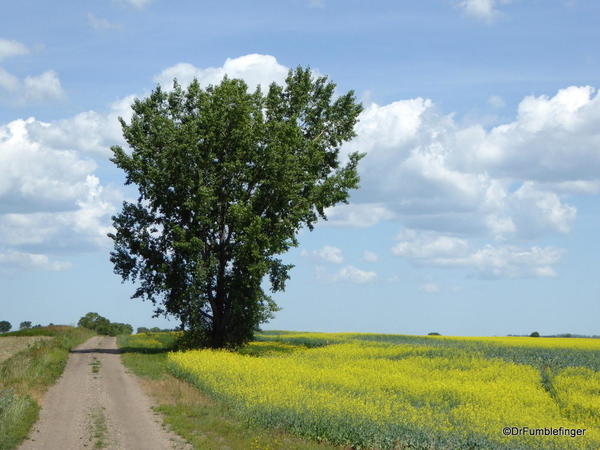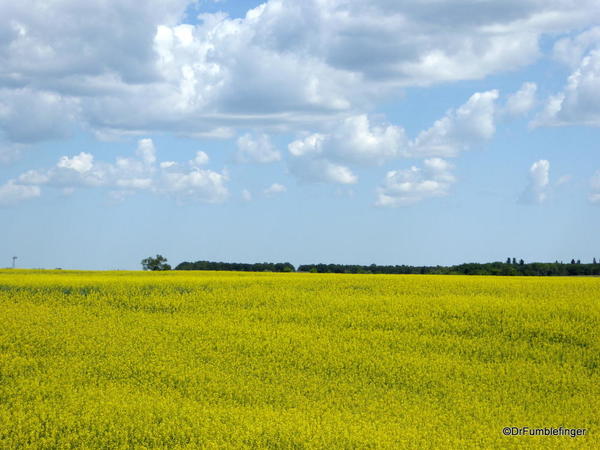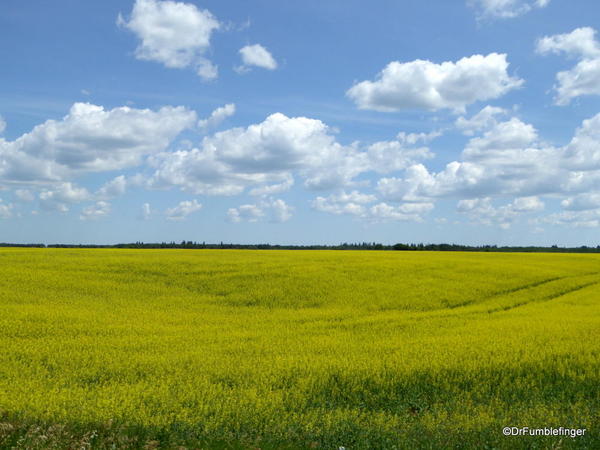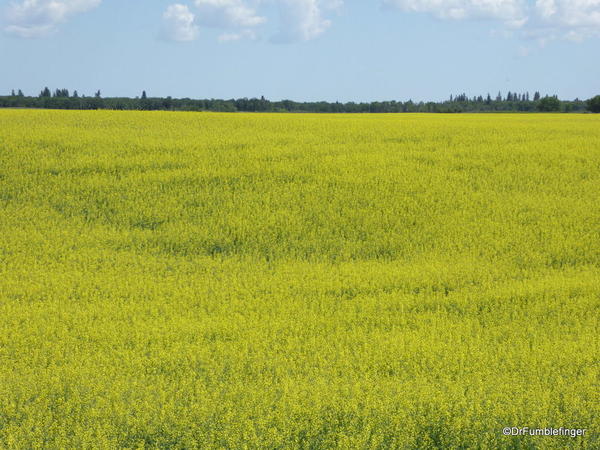I had a pleasant drive across the Canadian prairies this summer with my father. While the landscape is flat and lacks relief, it was a great time to do the trip because the canola and flax were blooming, adding a lot of color to the landscape. And the first cutting of hay was being bailed, putting a fresh pleasant scent in the wind. Â
Canola has become a popular crop in Canada these past few decades and canola fields are everywhere/1 The plants are about a meter high and produce beautiful small yellow flowers that ripen into bean-like pods. Black seeds from the pods are harvested and crushed to create canola oil and meal.  Canola seeds contain about 45 percent oil which is a popular cooking oil because of it's light quality and low saturated fat/heart healthy composition. Most cooking oil in Canada is canola oil. The canola meal is high in protein and is used to feed animals.
Canola belongs to the same family as mustard, broccoli, Brussels sprouts and cauliflower. Although they look alike, canola and rapeseed oils are quite different. Canadian scientists used traditional plant breeding in the 1960s to eliminate the undesirable components of rapeseed (toxic erucic acid and glucosinolates) and created "canola," a contraction of "Canadian" and "ola."Â
I had a pleasant drive across the Canadian prairies this summer with my father. While the landscape is flat and lacks relief, it was a great time to do the trip because the canola and flax were blooming, adding a lot of color to the landscape. And the first cutting of hay was being bailed, putting a fresh pleasant scent in the wind. Â
Canola has become a popular crop in Canada these past few decades and canola fields are everywhere/1 The plants are about a meter high and produce beautiful small yellow flowers that ripen into bean-like pods. Black seeds from the pods are harvested and crushed to create canola oil and meal.  Canola seeds contain about 45 percent oil which is a popular cooking oil because of it's light quality and low saturated fat/heart healthy composition. Most cooking oil in Canada is canola oil. The canola meal is high in protein and is used to feed animals.
Canola belongs to the same family as mustard, broccoli, Brussels sprouts and cauliflower. Although they look alike, canola and rapeseed oils are quite different. Canadian scientists used traditional plant breeding in the 1960s to eliminate the undesirable components of rapeseed (toxic erucic acid and glucosinolates) and created "canola," a contraction of "Canadian" and "ola."Â
I had a pleasant drive across the Canadian prairies this summer with my father. While the landscape is flat and mostly lacks relief, it was a great time to do the trip because the canola and flax were blooming, adding a lot of color to the landscape. And the first cutting of hay was being bailed, putting a fresh pleasant scent in the air.

Canola has become a popular crop in Canada these past few decades and canola fields are everywhere. The plants are about a meter high and produce beautiful small yellow flowers that ripen into bean-like pods. Black seeds from the pods are harvested and crushed to create canola oil and meal. Canola seeds contain about 45 percent oil which is a popular cooking oil because of it's light quality and low saturated fat/heart healthy composition. Canola is the most commonly used cooking oil in Canada; the canola meal is high in protein and is used to feed animals.

Canola belongs to the same family as mustard, broccoli, brussels sprouts and cauliflower. Although they look alike, canola and rapeseed oils are quite different. Canadian scientists used traditional plant breeding in the 1960s to eliminate the undesirable components of rapeseed (toxic erucic acid and glucosinolates) and created "canola," a contraction of "Canadian" and "ola:" (oil).


I had a pleasant drive across the Canadian prairies this summer with my father. While the landscape is flat and lacks relief, it was a great time to do the trip because the canola and flax were blooming, adding a lot of color to the landscape. And the first cutting of hay was being bailed, putting a fresh pleasant scent in the wind. Â
Canola has become a popular crop in Canada these past few decades and canola fields are everywhere/1 The plants are about a meter high and produce beautiful small yellow flowers that ripen into bean-like pods. Black seeds from the pods are harvested and crushed to create canola oil and meal.  Canola seeds contain about 45 percent oil which is a popular cooking oil because of it's light quality and low saturated fat/heart healthy composition. Most cooking oil in Canada is canola oil. The canola meal is high in protein and is used to feed animals.
Canola belongs to the same family as mustard, broccoli, Brussels sprouts and cauliflower. Although they look alike, canola and rapeseed oils are quite different. Canadian scientists used traditional plant breeding in the 1960s to eliminate the undesirable components of rapeseed (toxic erucic acid and glucosinolates) and created "canola," a contraction of "Canadian" and "ola."Â

Comments (0)